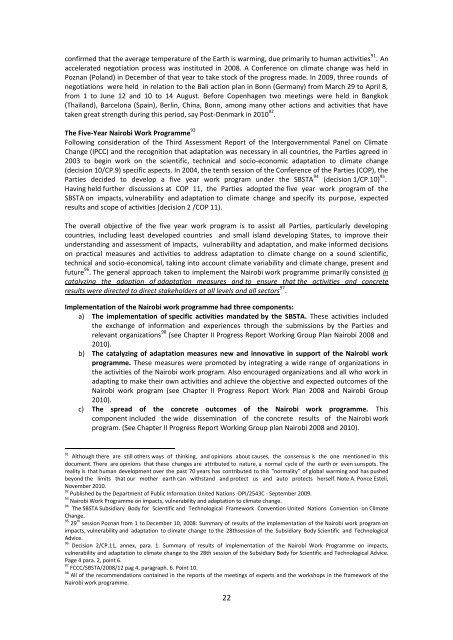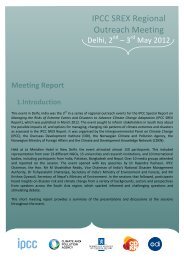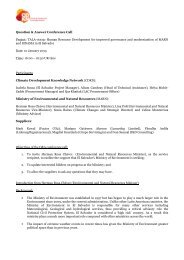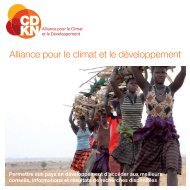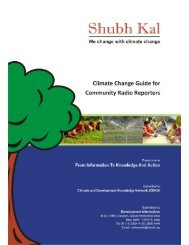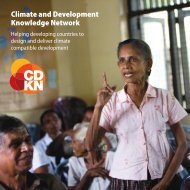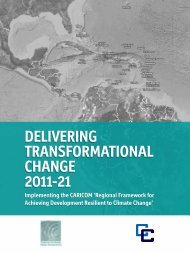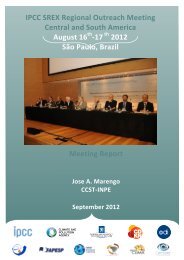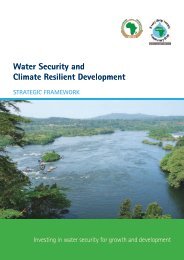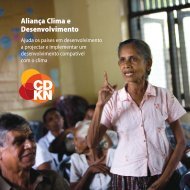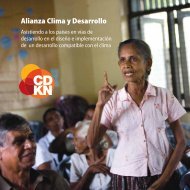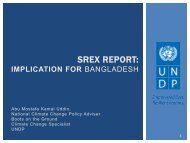confirmed that the average temperature of the Earth is warming, due primarily to human activities 91 . Anaccelerated negotiation process was instituted in 2008. A Conference on climate change was held inPoznan (Poland) in December of that year to take stock of the progress made. In 2009, three rounds ofnegotiations were held in relation to the Bali action plan in Bonn (Germany) from March 29 to April 8,from 1 to June 12 and 10 to 14 August. Before Copenhagen two meetings were held in Bangkok(Thailand), Barcelona (Spain), Berlin, China, Bonn, among many other actions and activities that havetaken great strength during this period, say Post-Denmark in 2010 92 .The Five-Year Nairobi Work Programme 93Following consideration of the Third Assessment Report of the Intergovernmental Panel on ClimateChange (IPCC) and the recognition that adaptation was necessary in all countries, the Parties agreed in2003 to begin work on the scientific, technical and socio-economic adaptation to climate change(decision 10/CP.9) specific aspects. In 2004, the tenth session of the Conference of the Parties (COP), theParties decided to develop a five year work program under the SBSTA 94 (decision 1/CP.10) 95 .Having held further discussions at COP 11, the Parties adopted the five year work program of theSBSTA on impacts, vulnerability and adaptation to climate change and specify its purpose, expectedresults and scope of activities (decision 2 /COP 11).The overall objective of the five year work program is to assist all Parties, particularly developingcountries, including least developed countries and small island developing States, to improve theirunderstanding and assessment of impacts, vulnerability and adaptation, and make informed decisionson practical measures and activities to address adaptation to climate change on a sound scientific,technical and socio-economical, taking into account climate variability and climate change, present andfuture 96 . The general approach taken to implement the Nairobi work programme primarily consisted incatalyzing the adoption of adaptation measures and to ensure that the activities and concreteresults were directed to direct stakeholders at all levels and all sectors 97 .Implementation of the Nairobi work programme had three components:a) The implementation of specific activities mandated by the SBSTA. These activities includedthe exchange of information and experiences through the submissions by the Parties andrelevant organizations 98 (see Chapter II Progress Report Working Group Plan Nairobi 2008 and2010).b) The catalyzing of adaptation measures new and innovative in support of the Nairobi workprogramme. These measures were promoted by integrating a wide range of organizations inthe activities of the Nairobi work program. Also encouraged organizations and all who work inadapting to make their own activities and achieve the objective and expected outcomes of theNairobi work program (see Chapter II Progress Report Work Plan 2008 and Nairobi Group2010).c) The spread of the concrete outcomes of the Nairobi work programme. Thiscomponent included the wide dissemination of the concrete results of the Nairobi workprogram. (See Chapter II Progress Report Working Group plan Nairobi 2008 and 2010).91 Although there are still others ways of thinking, and opinions about causes, the consensus is the one mentioned in thisdocument. There are opinions that these changes are attributed to nature, a normal cycle of the earth or even sunspots. Thereality is that human development over the past 70 years has contributed to this "normality" of global warming and has pushedbeyond the limits that our mother earth can withstand and protect us and auto protects herself. Note A. Ponce Estelí,November 2010.92 Published by the Department of Public Information United Nations -DPI/2543C - September 2009.93 Nairobi Work Programme on impacts, vulnerability and adaptation to climate change.94 The SBSTA Subsidiary Body for Scientific and Technological Framework Convention United Nations Convention on ClimateChange.95 29 th session Poznan from 1 to December 10, 2008: Summary of results of the implementation of the Nairobi work program onimpacts, vulnerability and adaptation to climate change to the 28thsession of the Subsidiary Body Scientific and TechnologicalAdvice.96 Decision 2/CP.11, annex, para. 1. Summary of results of implementation of the Nairobi Work Programme on impacts,vulnerability and adaptation to climate change to the 28th session of the Subsidiary Body for Scientific and Technological Advice.Page 4 para. 2, point 6.97 FCCC/SBSTA/2008/12 pag 4, paragraph. 6. Point 10.98 All of the recommendations contained in the reports of the meetings of experts and the workshops in the framework of theNairobi work programme.22
Central American Governments should take into account the international context, the mainagreements and negotiations in the development of strategic plans, respecting international and humanrights, to achieve integration, harmonization, alignment and ownership of their adaptation strategies assub-region as well as, to each country member of SICA. Also, the articulation of these strategies withlocal processes of adaptation and risks mitigation within each country. It is necessary to build acomplete set of gears that allows the articulation of these efforts, in reality; the different areasmentioned in the section of DRR are turning with everyone at their own pace, with different agendasand priorities. The question is: Who takes the role and the effort to articulate and be the shaft thatengages all of these circles and spheres that have their own dynamics?, Who will assume it, and does soin the context of the sub- region and who within each country? Local governments can play animportant role, but have neither sufficient expertise in the subject of adaptation and CCA nor theresources, if they had the resources to articulate these and other efforts in the territories, communitieswould be in a favorable position compared to current and future risks.The Bali Action Plan 99The Bali Action Plan focuses on four key issues: mitigation, adaptation, technology and financing, andincludes a discussion of a "shared vision" regarding long-term cooperation and long-term global goal toreduce emissions 100 .MitigationIn the context of international negotiations on climate change, the term "mitigation" is understood asthe reduction of greenhouse gases emissions. The questions have focused on how much mitigation isneeded to occur at a worldwide level? Which countries have to achieve it and how much will it cost? Toagree on actions that are “measurable, reportable and verifiable" are a fundamental feature of the BaliAction Plan. For industrialized countries, the analysis has focused on the commitments to achieve legallybinding emission reductions. For developing countries, the key was to determine “appropriatemitigation plans at a national level” and establish a process to record and support national actions.Emission Trends 101 .• Between 1972 and 2004, emissions of greenhouse gases increased by 70% and CO2 as the majorportion of Greenhouse Gases (77% of total emissions of greenhouse gases) increased by about 80%.• If additional policies are not implemented, the projected global emissions of greenhouse gases willincrease by 25 to 90% for 2030, compared with the year 2000.• CO2 emissions from energy use are likely to increase by 40 to 110% in that period.• Mitigation costs in 2030 would exceed 3% of world GDP 102 .In Central America, the effects of climate change have been specifically evident in the pattern ofbehavior of rainfall, the increase in extreme events such as hurricanes, storms and heavy rains, droughtsand rising temperatures. At meetings of the Central American Presidents in Honduras in November 2009and of the Vice-Presidents in 2010 in Guatemala, as well as sessions led by the Agriculture Ministershave agreed on the need for a unique position as a sub region on climate change 103 . The CentralAmerican dry arc will be affected by the reduction of precipitation by up to 37% according to climatescenarios of the IPCC and the elaborate country profiles. It is also likely that targeted sites temperatureincrease beyond the 3C°. This situation is of concern to the livelihoods of99 Report of the COP13, Bali, from 3 to 15 December 2007. Addendum. Part Two: Decisions adopted by the Conference of theParties) FCCC/CP/2007/6/Add1, 14/03/2008. Quoted in the Position Paper on Adaptation to Climate Change. OILWATCH.100 Even if the emissions are reduced to "zero", by the cumulative effect, the effects of global warming will be impossible to stop,by which the adaptation is a reality to which the countries of the world and especially the least developed must be taken verymuch into account from now on development plans and national and local policies. Note A. Ponce, November 2010.101 The future effects of global warming can be reduced only if it can reduce concentrations of greenhouse gases in the Earth'satmosphere, hence a large extent, a large part of the achievements of adaptation actions, reducing disaster risk on thesustainability of livelihoods of people are linked to the efforts of developing countries and emerging contaminants to some extent.If the strategies local, national and sub-regional and disaster mitigation efforts and risk mitigation and adaptation do not have thisgreat effort of GHG emitting countries the lives of vast populations and countries is a high risk of succumbing. The damage will beirreversible. Note A. Ponce, Estelí, March 2011.102 Source: IPCC. .103 Statement of the Central American Presidents to address climate change, Honduras November 2009.23
- Page 3 and 4: Executive SummaryCentral America is
- Page 5 and 6: Central is located in the "Ring of
- Page 7 and 8: Study ContentAs an innovative theme
- Page 9 and 10: that coexist in the universe. This
- Page 11 and 12: Central America level, is the only
- Page 13 and 14: of Mesoamerica has been explained a
- Page 15 and 16: possesses effective cultural commun
- Page 17 and 18: Additionally, to succeed and achiev
- Page 19 and 20: eforestation, hydrological planning
- Page 21: General thematic introduction on Cl
- Page 25 and 26: projected 109 conditions, changes o
- Page 27 and 28: General introduction on the themati
- Page 29 and 30: participatory manner, to address di
- Page 31 and 32: Causes and complementary consequenc
- Page 33 and 34: Organizational and legal contextWhi
- Page 35 and 36: The three bodies within the SICA ar
- Page 37 and 38: Based on research of available info
- Page 39 and 40: SE-CONREDCivilProtectionSNETCCNISCO
- Page 41 and 42: Synergy model that displays the add
- Page 43 and 44: Added value of indigenous and local
- Page 45 and 46: They do not work in a separate mann
- Page 47 and 48: demand for agricultural raw materia
- Page 49 and 50: Amazon DIPECHO Project “Strengthe
- Page 51 and 52: Indigenous Knowledge on DisasterMit
- Page 53 and 54: The combination of indigenous andsc
- Page 55 and 56: Indigenous Skills and the mysticism
- Page 57 and 58: Weather forecast through indigenous
- Page 59 and 60: In various international convention
- Page 61 and 62: Recommended ReadingBennett, A., 200
- Page 63 and 64: ILO, 1993, Convenio sobre pueblos i
- Page 65 and 66: Local knowledgeIncludes people and
- Page 67 and 68: which are threatswith a certainprob
- Page 69 and 70: Appreciates and respects their orga
- Page 71 and 72: framework, without taking into acco
- Page 73 and 74:
Currently Cacaopera ethnicity, alth
- Page 75 and 76:
IDH 228 For 2007 is of 0.6999Politi
- Page 77 and 78:
The Mayangnas are people who are de
- Page 79 and 80:
Rights of detainees to receive info
- Page 81 and 82:
Heritage Protection Article 128The
- Page 83 and 84:
19/09/1996 Law no. 230 Amendments a
- Page 85 and 86:
Indigenous Population:IDH 241 In 20
- Page 87 and 88:
Honduras, each has a different orig
- Page 89 and 90:
MISQUITOS 248 :In 1996 there were 3
- Page 91:
Internationalconventions signed wit


